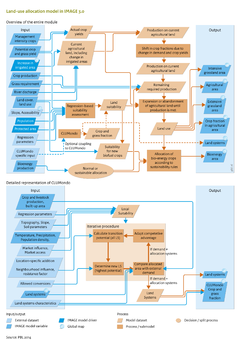Land-use allocation: Difference between revisions
Jump to navigation
Jump to search
No edit summary |
No edit summary |
||
| Line 4: | Line 4: | ||
|KeyReference=Doelman et al., in prep; Van Asselen and Verburg, 2012; Verburg et al., 2013; | |KeyReference=Doelman et al., in prep; Van Asselen and Verburg, 2012; Verburg et al., 2013; | ||
|InputVar=Management intensity crops; Increase in irrigated area - grid; Grass requirement; Bioenergy production; River discharge - grid; Protected area - grid; Land cover, land use - grid; Population - grid; Potential crop and grass yield - grid; Crop production; | |InputVar=Management intensity crops; Increase in irrigated area - grid; Grass requirement; Bioenergy production; River discharge - grid; Protected area - grid; Land cover, land use - grid; Population - grid; Potential crop and grass yield - grid; Crop production; | ||
|Parameter=Accessibility - grid; Regression parameters | |Parameter=Accessibility - grid; Regression parameters; Slope - grid; Other crops; Optional: CLUmondo specific input - grid; | ||
|OutputVar=Crop fraction in agricultural area - grid; Bioenergy area; Extensive grassland area - grid; Agricultural area - grid; Land suitability - grid; Intensive grassland area; Land systems - grid; | |OutputVar=Crop fraction in agricultural area - grid; Bioenergy area; Extensive grassland area - grid; Agricultural area - grid; Land suitability - grid; Intensive grassland area; Optional: Land systems - grid; | ||
|Description=About one third of the Earth’s land area is under cropland and pasture. The proportion of areas suitable for agriculture that is already in use is even larger. Humans strongly depend on agricultural production, as supported by soils and climatic circumstances, and thus need to rely on a continued functioning of these systems. On the other hand, major environmental problems rise from the size and intensity of agricultural land use, for example greenhouse gas emissions, distortions of the nutrient and water cycles, and biodiversity loss. Total agricultural area, globally or in a region, may be sufficient to assess the first order effects of production potential and environmental impacts. However, the location of agricultural land in a region or landscape is extremely important because yields of crops and grass depend on soil and climate, and also on spatially heterogeneous socio-economic factors, and because many impacts are location dependent. | |Description=About one third of the Earth’s land area is under cropland and pasture. The proportion of areas suitable for agriculture that is already in use is even larger. Humans strongly depend on agricultural production, as supported by soils and climatic circumstances, and thus need to rely on a continued functioning of these systems. On the other hand, major environmental problems rise from the size and intensity of agricultural land use, for example greenhouse gas emissions, distortions of the nutrient and water cycles, and biodiversity loss. Total agricultural area, globally or in a region, may be sufficient to assess the first order effects of production potential and environmental impacts. However, the location of agricultural land in a region or landscape is extremely important because yields of crops and grass depend on soil and climate, and also on spatially heterogeneous socio-economic factors, and because many impacts are location dependent. | ||
Revision as of 15:11, 4 November 2016
Parts of Land-use allocation
| Component is implemented in: |
| Components: |
| Related IMAGE components |
| Projects/Applications |
| Key publications |
| References |
Key policy issues
- How will changes in agricultural demand and trade affect future land-use patterns?
- How will land-use regulation, such as protected areas and REDD schemes, affect future land use and the impacts of land-use change?
- How can agricultural intensification increase global food production, and what policies will contribute to this?
